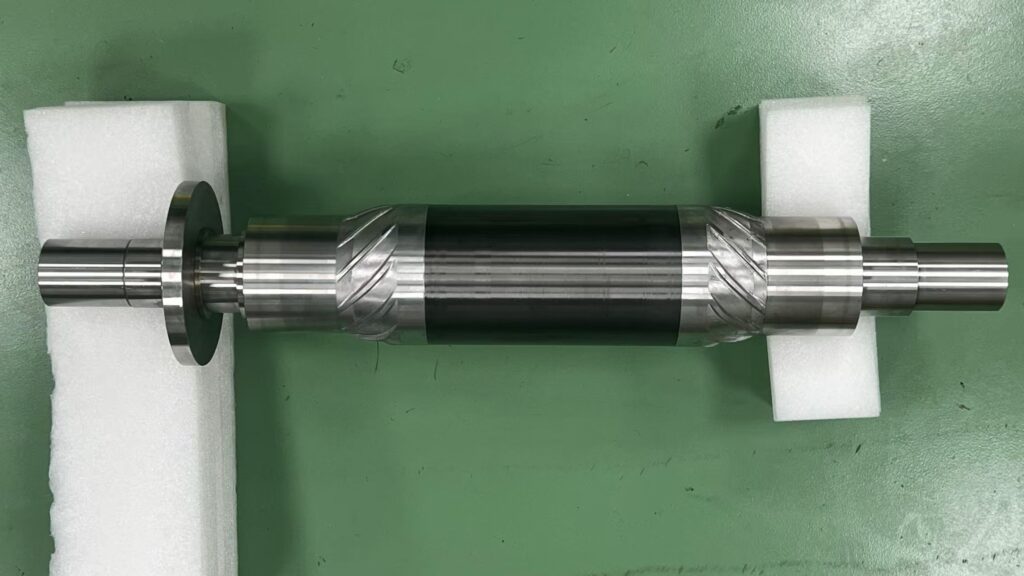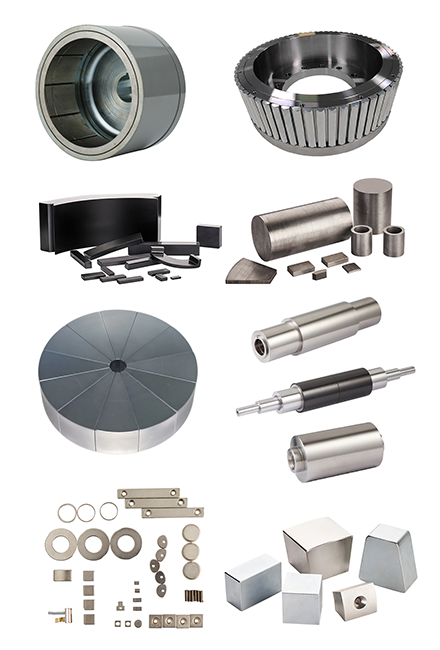
Magnetic levitation motor rotor-technological breakthrough
Hangzhou Magnet Power Technology Co., Ltd. is located in Qiantang District, Hangzhou. Founded by a team of PhDs from the Chinese Academy of Sciences, the company adheres to the talent philosophy of “Uniting Talents with Magnetic Force” and has gathered outstanding professionals to form a highly skilled and experienced team. Since its establishment, the company has been dedicated to the R&D and production of high-end rare earth permanent magnet materials and devices, committed to providing customers with high-quality and high-performance magnetic levitation motor rotor products. With its exceptional technical capabilities, the company has successfully mastered the production technologies of high-performance samarium-cobalt, neodymium-iron-boron, and magnetic device products. Its products are widely used in high-performance motors, the Internet of Things, medical fields, and other industries, earning trust and praise from customers. Its technical strength and innovative achievements in the field of magnetic levitation motor rotors have not only laid a solid foundation for the company’s development but also injected new vitality into the entire industry. Next, let’s take an in-depth look at the unique advantages of Hangzhou Magnet Power Technology Co., Ltd. in the core technologies of magnetic levitation motor rotors.

Precise Machining and Heat Treatment
(1) Advanced Machining Processes
In the production of magnetic levitation motor rotors, the shaft, as a core component, its machining accuracy directly affects the performance and stability of the motor. Hangzhou Magnet Power Technology Co., Ltd. is well aware of this and has invested significant efforts and resources in shaft machining processes, adopting a series of advanced processing equipment and techniques to ensure the dimensional accuracy of the shafts.
The company is equipped with multiple high-precision five-axis (five-axis simultaneous) machining centers, which have excellent processing capabilities and can achieve high-precision machining of complex curved surfaces. During shaft machining, the five-axis machining centers can control the movement of five coordinate axes simultaneously, allowing the tool to cut the shaft at various angles and directions, thus achieving precise machining of all parts of the shaft. Compared with traditional processing equipment, five-axis machining centers greatly reduce the number of clamping operations, minimize dimensional deviations caused by clamping errors, and improve processing efficiency and accuracy.
In addition to five-axis machining centers, the company has also introduced high-precision CNC lathes. CNC lathes can automatically perform machining according to pre-programmed procedures, with high machining accuracy and stability, ensuring that key dimensions such as the outer diameter and inner hole of the shaft are controlled within extremely small tolerance ranges. During processing, CNC lathes can also automatically adjust processing parameters through real-time monitoring and feedback systems, further ensuring the stability of machining accuracy.
To ensure the reliability of machining accuracy, the company also uses online inspection technology. During processing, high-precision measuring instruments are used to monitor the shaft’s dimensions in real time. If any dimensional deviation exceeds the allowable range, the system will automatically adjust the processing parameters immediately, ensuring that each shaft meets the designed accuracy standards. This online inspection technology not only improves product quality stability but also reduces the rejection rate and production costs.
(2) Unique Heat Treatment Technology
In addition to advanced machining processes, Hangzhou Magnet Power Technology Co., Ltd. also has unique expertise in shaft heat treatment technologies. The company uses special heat treatment processes such as vacuum quenching and tempering, which can significantly improve the mechanical properties of the shaft, ensuring it maintains good stability and reliability under high-speed rotation conditions.
Vacuum quenching is a quenching process carried out in a vacuum environment. Compared with traditional quenching processes, vacuum quenching has advantages such as no oxidation, no decarburization, and minimal quenching deformation. In a vacuum environment, the shaft surface does not react with impurities such as oxygen, avoiding oxidation and decarburization and ensuring the surface quality and performance of the shaft. At the same time, due to the uniform cooling rate during vacuum quenching, the shaft undergoes minimal deformation, effectively reducing subsequent processing workload.
Tempering is a heat treatment process performed on the shaft after quenching to eliminate internal stresses generated during quenching and improve the shaft’s toughness and comprehensive mechanical properties. Hangzhou Magnet Power Technology Co., Ltd. precisely controls parameters such as tempering temperature, time, and cooling rate to optimize the shaft’s microstructure, thereby significantly improving its toughness and fatigue resistance while ensuring hardness.
Through the synergistic effect of special heat treatment processes such as vacuum quenching and tempering, the shafts produced by Hangzhou Magnet Power Technology Co., Ltd. have excellent mechanical properties. Under high-speed rotation, the shafts can withstand enormous centrifugal forces and torques, making them less prone to deformation, fracture, or other failures, providing a solid guarantee for the stable operation of magnetic levitation motors.

Magnetic Steel Design and Assembly
(1) Innovative Tooling Design
In the magnetic steel assembly process, the design and manufacturing of tooling play a crucial role. Relying on its strong R&D capabilities, Hangzhou Magnet Power Technology Co., Ltd. has independently developed a set of high-precision magnetic steel assembly tooling. This tooling adopts advanced design concepts and manufacturing processes, with multiple innovative functions that effectively improve the efficiency and accuracy of magnetic steel assembly.
The tooling uses a high-precision positioning mechanism to ensure that the positional accuracy of magnetic steel during assembly is within ±0.01mm. Through a unique positioning design, the tooling can accurately position the magnetic steel in the predetermined position, avoiding assembly errors caused by positioning deviations and ensuring the accuracy and consistency of magnetic steel assembly.
(2) Strict Control of Magnetic Steel Performance
As a key component of magnetic levitation motor rotors, the performance of magnetic steel directly affects the motor’s performance and reliability. Therefore, Hangzhou Magnet Power Technology Co., Ltd. has implemented a series of strict measures to control magnetic steel performance, ensuring that each piece of magnetic steel has stable and excellent performance.
The company strictly selects magnetic steel raw materials, establishing long-term and stable cooperative relationships with renowned domestic and international magnetic steel raw material suppliers to ensure the quality of raw materials. During the procurement process, the company strictly inspects raw materials according to relevant standards, and only those that meet the standards can enter the production process. The magnetic properties, chemical composition, density, and other parameters of the magnetic steel raw materials are strictly tested to ensure their performance meets design requirements.
During magnetic steel production, the company uses advanced production processes and equipment to strictly control every (process) of production, ensuring stable magnetic steel performance. By precisely controlling parameters such as sintering temperature, time, and magnetic field, the crystal structure of the magnetic steel is optimized to improve its magnetic properties. The company has also established a complete quality inspection system, conducting comprehensive performance tests on each piece of magnetic steel produced, including measurements of magnetic flux, coercive force, remanence, and other parameters. Only qualified magnetic steel can proceed to the next process.
Through strict control of magnetic steel performance, the magnetic steel produced by Hangzhou Magnet Power Technology Co., Ltd. has advantages such as high magnetic energy product, high coercive force, and low temperature coefficient, and can maintain stable performance in various harsh working environments.

Carbon Fiber Technology
(1) Advantages of Winding Technology
In the manufacturing of magnetic levitation motor rotors, carbon fiber winding technology plays a key role. The carbon fiber winding process adopted by Hangzhou Magnet Power Technology Co., Ltd. has many significant advantages, effectively reducing rotor weight while greatly improving its strength and stability.
Carbon fiber materials have the characteristics of low density, high strength, and high modulus. Their density is only about one-quarter that of steel, yet they have far higher strength than steel. Through precise winding processes, carbon fibers are tightly wound around the rotor surface to form a strong protective structure. This structure ensures the rotor has sufficient strength and stability while significantly reducing its overall weight. A lighter rotor can reduce energy loss during high-speed rotation, improving the motor’s efficiency and response speed, making it more agile during start-up, acceleration, and deceleration.
The wound carbon fiber layer can evenly distribute stress, enhancing the rotor’s structural stability, allowing it to maintain good shape and performance under the enormous centrifugal force generated by high-speed rotation, effectively avoiding the risk of deformation or damage due to stress concentration.
(2) Key Points of Process Control
Precise control of various process parameters during carbon fiber winding is crucial to ensuring winding quality and rotor performance. Hangzhou Magnet Power Technology Co., Ltd. has accumulated rich experience in this area, strictly controlling parameters such as fiber tension, number of layers, and winding angle.
Control of fiber tension is of utmost importance. If the tension is too low, the carbon fiber cannot be tightly wound around the rotor surface, resulting in uneven density of the winding layer and affecting the rotor’s strength and stability. If the tension is too high, the carbon fiber may be excessively stretched during winding, reducing its own performance or even causing fiber breakage. Therefore, the company uses an advanced tension control system to precisely adjust the fiber tension during winding according to the carbon fiber’s characteristics and rotor design requirements, keeping it within the optimal range to ensure each layer of carbon fiber is tightly and evenly wound around the rotor.
Determining the number of winding layers also requires comprehensive consideration of multiple factors. Too few layers cannot provide sufficient strength and protection for the rotor, while too many layers will increase rotor weight and cost and may affect motor performance. The company determines the optimal number of winding layers through mechanical analysis and simulation calculations of the rotor, combined with actual application requirements, to achieve the best balance between performance and cost.
The fiber winding angle also significantly impacts rotor performance. Different winding angles change the stress distribution and structural characteristics of carbon fibers on the rotor surface, thereby affecting the rotor’s strength, stiffness, and stability. The company uses advanced mathematical models and simulation technologies to accurately calculate the optimal winding angle, ensuring that carbon fibers can fully leverage their performance advantages in all directions, providing comprehensive protection and enhancement for the rotor.
Through precise control of parameters such as fiber tension, number of layers, and winding angle, Hangzhou Magnet Power Technology Co., Ltd. can produce carbon fiber-wound magnetic levitation motor rotors with superior performance, meeting the needs of different customers and application scenarios.

Dynamic Balancing Technology
(1) High-Precision Dynamic Balancing Equipment
Hangzhou Magnet Power Technology Co., Ltd. uses advanced high-precision dynamic balancing equipment in the production of magnetic levitation motor rotors, providing a solid hardware foundation for ensuring rotor dynamic balancing accuracy. The company has introduced fully automatic dynamic balancing machines with excellent performance and high automation.
This fully automatic dynamic balancing machine uses advanced sensor technology to accurately measure vibration signals during rotor rotation. Through real-time collection and analysis of these signals, the dynamic balancing machine can quickly and accurately determine the rotor’s unbalance amount and position, with a measurement accuracy of up to ±0.01g・mm, far exceeding industry average levels.
During operation, operators only need to install the rotor to be balanced on the dynamic balancing machine. After starting the equipment, the dynamic balancing machine automatically completes a series of operations such as measurement, calculation, and correction, requiring minimal manual intervention. This highly automated operation not only improves work efficiency but also reduces the impact of human factors on balancing accuracy, ensuring that each rotor meets high-precision dynamic balancing standards.
(2) Balancing Strategies and Algorithms
In addition to advanced dynamic balancing equipment, Hangzhou Magnet Power Technology Co., Ltd. also uses vibration analysis-based balancing strategies and intelligent algorithms to achieve more efficient and precise dynamic balancing corrections. The company’s technical team has conducted in-depth research on the vibration characteristics of magnetic levitation motor rotors and developed a targeted balancing strategy based on years of practical experience.
During dynamic balancing correction, high-precision vibration sensors first comprehensively collect the rotor’s vibration signals. These sensors are distributed at different positions on the rotor to real-time monitor vibration in all directions. Then, intelligent algorithms are used to deeply analyze the collected vibration signals, accurately identifying the rotor’s unbalance amount and position.
The intelligent algorithms adopted by the company are based on advanced mathematical models and artificial intelligence technologies, capable of quickly processing large amounts of vibration data and extracting key information. The algorithms have self-learning and adaptive capabilities, able to automatically adjust balancing strategies according to different rotor structures and working conditions to achieve optimal balancing effects.
Through this vibration analysis-based balancing strategy and intelligent algorithms, Hangzhou Magnet Power Technology Co., Ltd. can complete dynamic balancing correction of magnetic levitation motor rotors in a short time, effectively improving production efficiency. After correction, the rotor’s vibration amplitude is significantly reduced, enabling stable operation at high speeds.

Magnetization Technology
(1) Advantages of Post-Magnetization Capability
Hangzhou Magnet Power Technology Co., Ltd. has the capability of post-magnetization, a technical advantage of great significance in the production of magnetic levitation motor rotors. Post-magnetization technology allows magnetic steel to be magnetized after completing assembly and other processes, effectively improving production flexibility. In the production process, if pre-magnetization is used, magnetic steel is prone to interference from external factors during subsequent handling and assembly, leading to degradation of magnetic performance. Using post-magnetization technology avoids these issues, greatly reducing the risk of magnetic performance degradation and ensuring that the magnetic performance of magnetic levitation motor rotors remains stable during long-term use.
(2) Magnetization Equipment and Processes
The company is equipped with advanced magnetization equipment that uses the latest technology to generate high-intensity, uniform, and stable magnetic fields, meeting the magnetization needs of different types of magnetic steel. In terms of magnetization processes, Hangzhou Magnet Power Technology Co., Ltd. has a professional technical team that has developed a set of precise magnetization processes through years of research and practice. Before magnetization, technicians accurately set various parameters of the magnetization equipment based on the magnetic steel’s material, shape, size, and required magnetic performance to ensure the accuracy and stability of the magnetization process. During magnetization, technicians real-time monitor the operation status of the magnetization equipment and the magnetization condition of the magnetic steel, adjusting magnetization parameters in a timely manner to ensure uniform magnetization of the magnetic steel, so that each magnetic levitation motor rotor has stable and consistent magnetic performance.
Applications of Magnetic Levitation Motor Rotors
(1) Wide Range of Application Fields
The magnetic levitation motor rotors with a rotation speed ≥10,000 RPM produced by Hangzhou Magnet Power Technology Co., Ltd., with their excellent performance, are widely used in many fields. In the aerospace field, magnetic levitation motor rotors are applied to the propulsion systems and attitude control systems of aircraft. Due to their high speed, high efficiency, and low vibration characteristics, they can provide strong and stable power for aircraft while reducing mechanical wear and energy consumption, improving aircraft reliability and endurance. In satellite attitude adjustment devices, magnetic levitation motor rotors can achieve precise angle control, ensuring stable satellite operation in space.
In the high-speed rail field, magnetic levitation motor rotors, as core components, provide key support for the high-speed operation of trains. For example, Shanghai Maglev Train in China adopts advanced magnetic levitation technology, in which the high-performance operation of magnetic levitation motor rotors enables the train to travel at extremely high speeds while maintaining smoothness and low noise. The high-precision dynamic balancing and stable magnetic performance of Hangzhou Magnetic Force’s magnetic levitation motor rotors can effectively reduce vibration and energy consumption during train operation, improving operational efficiency and safety.
In the industrial field, magnetic levitation motor rotors also play an important role. In high-precision machine tools, they can achieve high-speed and high-precision rotational motion, improving machining accuracy and surface quality. In semiconductor manufacturing equipment, the application of magnetic levitation motor rotors can meet the requirements for ultra-clean and high-precision environments, ensuring the quality and stability of chip manufacturing.
(2) Technology Development Trends
Hangzhou Magnet Power Technology Co., Ltd. has broad R&D directions and innovative prospects in magnetic levitation motor rotor technology. With the continuous advancement of technology, the performance requirements for magnetic levitation motor rotors will become increasingly higher. In material R&D, the company will explore the application of new materials, such as higher-performance rare earth permanent magnet materials and new composite materials, to enhance the magnetic properties of magnetic steel and the structural strength of rotors. Through optimized material selection and design, it is expected to further reduce rotor weight while improving high-temperature resistance, corrosion resistance, and other properties, expanding the application range of magnetic levitation motor rotors.
The company will also strengthen cooperation with universities and research institutions to carry out industry-university-research joint innovations and jointly tackle key challenges in the field of magnetic levitation motor rotor technology. By integrating resources from all parties, it will accelerate technological innovation and achievement transformation, driving the continuous development of magnetic levitation motor rotor technology and providing more powerful technical support for the development of various industries.



